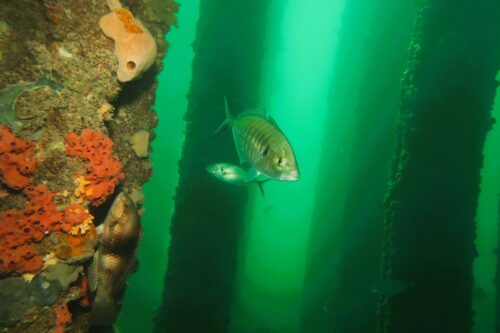David Muirhead recently posted this photo of a bluethroat wrasse, Notolabrus tetricus from old Rapid Bay jetty on 1st October 2022 on iNaturalist at https://inaturalist.ala.org.au/observations/139393179 : –

David gave the posting the following description (but with my punctuation, or the computer’s): –
“SUBJECT is the wrasse parked vertically near the red sponge on the Jetty pile on LHS. It is a current client of some Western Cleaner Clingfish not discernible in the photo. The significance of this observation lies more in the appearance of the trevally mid-frame because it has accentuated the dark bars on its body, signalling its need for cleaning.
“Free-swimming temperate pelagic fish such as Pseudocarynx georgianus can’t stop at a cleaning station in the way wrasses and most benthic or demersal species can. The need to keep swimming to maintain adequate oxygen levels requires a compromise, or the tiny, site attached hosts, being relatively weak swimmers (in this typical case Western Cleaner Clingfish, a.k.a. WCC) can’t service the client. The compromise seems to involve behavioural adaptation by both parties.
“The client, displaying the signature pattern, swims close to the station, either as slowly as possible (sometimes they can almost stay put, very near but not in direct physical contact with the sponge station facing into the current, but only if there is sufficient tidal flow)
or by repeating faster runs towards the station until it convinces the host(s) it warrants their attention. The host (usually a WCC) will then ‘jump onto’ the client and actively clear parasites while, albeit briefly, being carried some distance from its ‘home base ‘ (e.g. red sponge station).
“Usually, the client tries to remain as close as possible to the station, or the host might abandon it. Trevally either swim forwards a short distance then use any tidal current to drift backwards repeatedly
i.e.
short bursts of good oxygen uptake punctuated by the equivalent of transient breath holding
or
they will maintain forward movement by swimming in tight circles around the jetty pile that supports the host station so that when the WCC has finished with the client it can easily ‘hop ‘ back onto the station during one of the client’s passes.”

